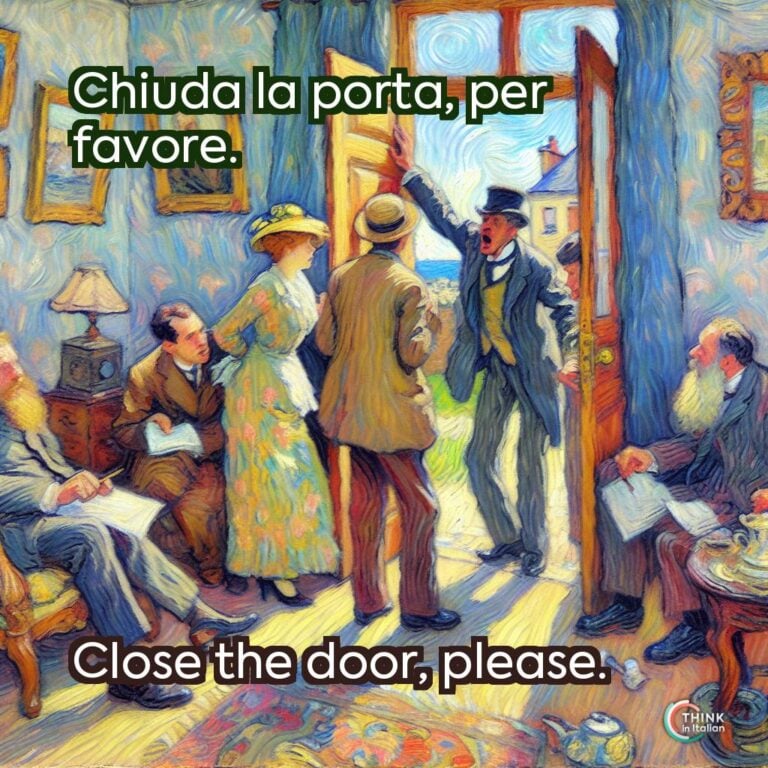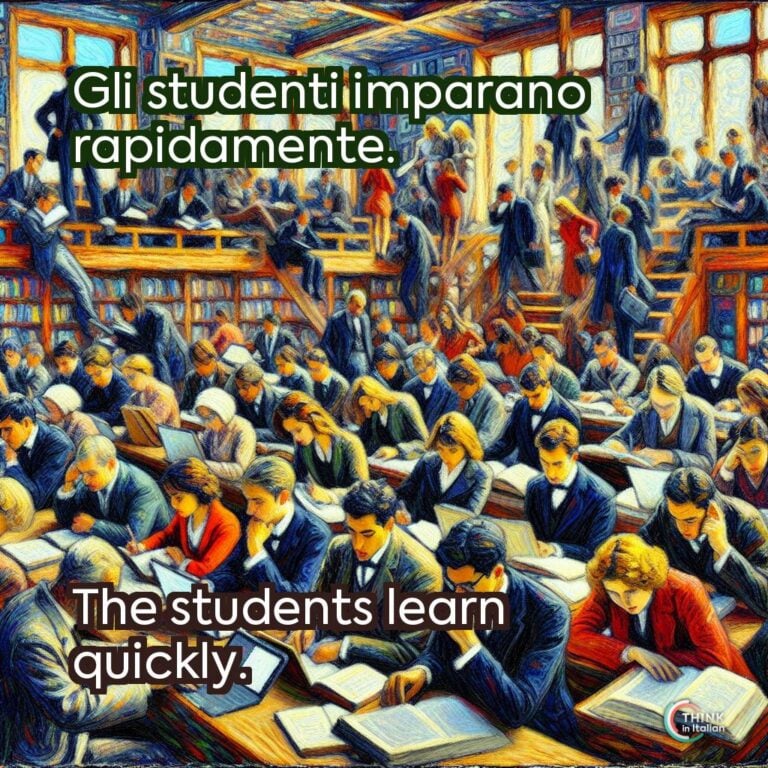Italian Grammar Lessons
Learn Italian grammar with easy-to-follow lessons and handy summaries authored by expert linguists. Examples with pictures help explain tricky parts, while fun practice tasks help you remember what you’ve learned.
Latest Grammar Notes
- Modal verbs in Italian include potere (can), volere (want), dovere (must), and sapere (know how to).
- These verbs must be followed by an infinitive verb, indicating the action being performed, such as posso cucinare (I can cook).
- Conjugation varies across tenses, with distinct forms in presente, imperfetto, and passato prossimo, essential for accurate communication.
- Combining modal verbs is possible, allowing for complex expressions, like devo saper sciare (I must know how to ski).
- Understanding the nuances of each modal verb helps convey ability, desire, obligation, and knowledge effectively in conversation.
- Relative pronouns link sentences by referring back to a previously mentioned noun or pronoun, enhancing sentence fluidity.
- The most common Italian relative pronoun is che, which translates to who, which, or that and does not change form.
- Cui is used with prepositions and indicates possession or relationships, translating to whom or which.
- Il quale is a more formal relative pronoun that varies in form based on the gender and number of the noun it refers to.
- To use relative pronouns correctly, identify the antecedent, learn necessary prepositions, and ensure proper gender and number agreement with il quale.
- Irregular verbs in Italian do not follow standard conjugation patterns, making them essential to learn by heart.
- Key irregular verbs include essere, avere, and andare, which are frequently used in everyday conversation.
- Learning these verbs engages declarative memory, as you must memorize specific forms rather than applying regular rules.
- Irregularities can occur in one or more tenses, with some verbs being irregular only in certain tenses.
- Regular practice and exposure to these verbs in different contexts will enhance fluency and confidence in using them.
- Reflexive pronouns in Italian indicate that the subject performs an action on itself, as seen in mi lavo (I wash myself).
- They precede the verb in finite forms and follow in non-finite forms, affecting sentence structure.
- Reflexive verbs require the auxiliary verb essere in the present perfect, with the past participle agreeing in gender and number.
- Common reflexive pronouns include mi, ti, si, ci, vi, and si for different subjects.
- Understanding the difference between reflexive, direct, and indirect object pronouns is crucial for clear communication in Italian.
- Italian ordinal numbers are adjectives that must agree in gender and number with the nouns they describe, affecting their endings.
- The first ten ordinal numbers are irregular and need to be memorized, while numbers beyond ten follow a predictable pattern with the -esimo suffix.
- In Italian, compound ordinal numbers are written as a single word, unlike in English where they are separated (e.g., trentaduesimo for “thirty-second”).
- Common uses of ordinal numbers include ordering food in restaurants and identifying floors in buildings, such as primo piano (first floor).
- Be cautious of confusing prima (first) with the adverb meaning “before” and secondo (second) with the phrase meaning “in my opinion.”
- The formal imperative in Italian is used to give commands to someone in a respectful or formal context, typically using lei.
- In the formal imperative, there is only one form for both affirmative and negative commands, unlike the informal imperative.
- Regular verbs follow a consistent pattern in the formal imperative, resembling the present subjunctive conjugation.
- Irregular verbs have unique forms in the formal imperative, such as Lei sia for “to be” and Lei abbia for “to have.”
- When comparing formal and informal imperatives, the endings switch: informal uses -a while formal uses -i.
A reader will learn about the intricacies of Italian nouns, including their classifications, gender and number rules, historical evolution, and practical usage tips.
- Nouns can be classified as proper, common, concrete, abstract, countable, or uncountable.
- Italian nouns have gender and number, typically indicated by their endings: -o for masculine and -a for feminine.
- Some nouns ending in -e can be either gender and require context to determine their gender.
- Historical evolution of Italian nouns shows many derive from Latin, influencing their current forms and usage.
- Understanding dialectal variations can enhance communication and comprehension of regional differences in Italian.
- Adverbs are essential modifiers in Italian, enhancing communication by providing details about actions, circumstances, and attributes.
- Italian adverbs can be categorized by meaning (e.g., manner, place, time) and morphology (derived or primitive).
- Unlike adjectives, Italian adverbs are invariable, simplifying their usage as they do not change with gender or number.
- Adverb placement is flexible in sentences, affecting emphasis and the overall meaning of statements.
- Common errors include misplacement of adverbs, over-reliance on certain adverbs, and inappropriate use of the -mente suffix.
- Mastering adverbs enhances fluency and precision in Italian, making communication more effective and nuanced.
- Ora che translates to “now that” and introduces a new situation, leading to a consequence or reaction.
- Use the indicative present or present perfect after ora che to convey current relevance.
- When ora che starts a sentence, use a comma to separate the clauses; no comma is needed if it appears in the middle.
- Una volta che means “once” and indicates a condition that must be completed before another action occurs.
- For una volta che, use future perfect for future actions and present perfect for past actions.
- When using una volta with a past participle, omit che and ensure agreement in gender and number.
- The congiuntivo presente is used when the main clause is in the present tense, expressing current likelihood or desire.
- The congiuntivo imperfetto applies when the main clause is in a past tense, reflecting past doubts or hypothetical situations.
- Understanding the structure of presente – presente for congiuntivo presente and passato – presente for congiuntivo imperfetto is crucial for correct usage.
- Examples illustrate that congiuntivo presente reflects current thoughts, while congiuntivo imperfetto relates to past reflections.
- Recognizing the timing of the main clause helps differentiate between the two subjunctive forms effectively.
- Qui means “here” and refers to a specific location close to the speaker.
- Qua translates to “this way” and indicates a general area near the listener.
- Di qua means “on this side” and suggests movement towards the speaker’s location.
- While qui is stationary and specific, qua can imply mobility or a broader area.
- In some contexts, qui and qua can be used interchangeably, but with different nuances.
- Ma is a neutral conjunction used to introduce a contrast between two clauses, often in everyday conversation.
- Però conveys a stronger sense of contrast, similar to “however,” and emphasizes the idea it introduces.
- Ma can express surprise or be used in exclamatory phrases, adding emotional weight to statements.
- Però is more flexible in placement, allowing it to appear at the beginning, middle, or end of a sentence.
- Using però can soften statements, making them feel less abrupt compared to using ma.
- Nouns ending in ‘e’ can be either masculine or feminine, with exceptions that require careful consideration.
- Common patterns include nouns ending in -o being masculine and those ending in -a being feminine.
- Examples like caffe (coffee) and strade (streets) illustrate the exceptions in gender assignment.
- Contextual clues, such as accompanying articles and adjectives, are essential for determining the gender of nouns.
- Practice and memorization of common patterns and exceptions can significantly improve your ability to identify noun genders.
- Italian verb tenses are categorized into finite and non-finite verbs, with finite verbs requiring a subject for conjugation.
- The Indicativo mood includes tenses like Presente, Passato Prossimo, and Futuro Semplice, used for factual statements.
- Congiuntivo expresses doubts and wishes, with tenses such as Presente and Imperfetto reflecting uncertainty.
- Condizionale conveys hypothetical situations, with Presente used for potential outcomes and Passato for unreal past scenarios.
- Non-finite verbs include Infinito, Gerundio, and Participio, which do not change form and serve specific grammatical functions.
- Italian is a Romance language that evolved from Vulgar Latin, showcasing its rich historical roots.
- Italian syntax typically follows a Subject-Verb-Object (SVO) order, but allows flexibility for emphasis and clarity in communication.
- Gender and number are crucial in Italian grammar; every noun, article, and adjective must agree in genere and numero.
- Italian verbs are categorized into three conjugations based on their endings: -are, -ere, and -ire, affecting their conjugation patterns.
- Pronouns in Italian replace nouns and can be direct or indirect, with specific placement rules that impact sentence structure.
- Mastering grammar is essential for fluency, enhancing communication and cultural understanding, allowing deeper engagement with the Italian language and heritage.
- Da quando saremo arrivati translates to “by the time we get there,” indicating actions that will occur before reaching a destination.
- The phrase combines da quando (since/when) and saremo arrivati (we will have arrived), emphasizing future completion.
- Use da quando saremo arrivati in contexts like travel, meetings, or event planning to express expectations before arriving.
- The expression da quando can also mean “since when,” helping to inquire about the starting point of actions or events.
- Incorporating this phrase into conversations enhances fluency and conveys anticipation regarding future events or actions.
- The verb fare means both “to do” and “to make,” showcasing its versatility in various contexts.
- It is an irregular verb, requiring specific attention to its conjugation across different tenses like presente, passato prossimo, and futuro semplice.
- Common expressions include fare colazione (to have breakfast) and fare una torta (to make a cake).
- In idiomatic expressions, fare bene means “to do good,” while fare male means “to do harm.”
- Mastering fare enhances communication skills and understanding of Italian culture and language nuances.
- Conjunctions are essential for connecting clauses, sentences, and words, enhancing the flow of ideas in Italian.
- There are two main types of conjunctions: coordinating (e.g., e, ma) and subordinating (e.g., perché, se).
- Coordinating conjunctions connect elements of equal rank, while subordinating conjunctions link dependent clauses to independent ones.
- Examples of correlative conjunctions include O…o (either…or) and Non solo…ma anche (not only…but also).
- Using conjunctions correctly can significantly improve the coherence and fluidity of your Italian conversations.
- Consistent practice with conjunctions is key to mastering their use and enhancing your overall communication skills in Italian.
- Regular verbs in Italian are categorized into three families based on their infinitive endings: -are, -ere, and -ire.
- The -are verbs are the most common, with consistent conjugation patterns across all tenses.
- Examples of regular verbs include parlare (to speak) and mangiare (to eat) in the -are family.
- -ere verbs, like scrivere (to write), have a slightly different conjugation pattern but still follow regular rules.
- The -ire family includes both regular verbs and those that add -isc- in some forms, like finire (to finish).
- Practice is essential for mastering these conjugation patterns, making them feel natural in conversation.
- The past progressive in Italian is formed using the imperfecto of stare plus the present gerund of the main verb.
- It expresses ongoing actions at a specific past moment, often interrupted by another action, similar to English.
- Use the past progressive for simultaneous actions happening at the same time or to set a scene in narratives.
- Remember to use the corresponding reflexive pronoun with reflexive verbs, which precedes the auxiliary verb in compound tenses.
- Distinguish between the imperfetto and the past progressive: the former describes ongoing states, while the latter emphasizes action continuity at a specific time.
- The present progressive in Italian is formed using the stare verb in the present indicative + the gerund of the main verb.
- Gerunds for -are verbs end in -ando, while -ere and -ire verbs end in -endo.
- Use the present progressive for current actions, temporary actions, and imminent future actions in Italian.
- Unlike English, the Italian present progressive cannot express a time span for imminent future actions.
- Distinguishing between the present tense and present progressive is essential for clarity in communication and expressing nuances in Italian.
- The expression da una parte… dall’altra translates to “on the one hand… on the other,” highlighting opposing sides of a situation.
- It is commonly used in both spoken and written Italian to present contrasting ideas or opinions effectively.
- The conjunction ma indicates contrast, while e connects ideas without conflict, showing coexistence.
- This structure helps to balance different perspectives, making it easier to analyze situations from multiple angles.
- Complex sentences using this expression can convey nuanced thoughts, enriching communication and understanding in discussions.
- Quando means both when and once, used similarly to English in various contexts.
- Quando functions as an interrogative adverb to ask about specific times, like birthdays or arrivals.
- As a conjunction, quando links sentences, indicating events occurring simultaneously, such as arrivals or unexpected events.
- Prepositions can follow quando, altering its meaning, like da quando (since when) and per quando (by when).
- Common expressions include Quando mai? (When ever) and Di quando in quando (From time to time), enriching conversational Italian.
- In Italian, “at least” translates to almeno, a versatile word used in both formal and informal contexts.
- Setting a minimum expectation is a common use of almeno, helping to clarify requests without being overly demanding.
- Expressing relief or consolation with almeno shifts focus to positive aspects, softening disappointment in various situations.
- When making suggestions, almeno helps to soften the tone, making advice feel more reasonable and encouraging.
- Almeno can also describe the bare minimum acceptable in a situation, emphasizing the smallest amount considered sufficient.
- “To go” in Italian is translated as andare, used for movement toward a specific destination.
- “To go out” translates to uscire, indicating leaving a place or social outings.
- Andare requires prepositions like a (to go to) or in (to go in), depending on the context.
- Uscire can be combined with da (to go out from) or con (to go out with) for clarity.
- Both verbs are irregular and require understanding their conjugations in various verb tenses for proper usage.
- The expression servire a indicates the purpose of an object or action in Italian.
- To use servire a, conjugate the verb servire in the 3rd person and follow it with an infinitive verb.
- It can also be followed by a noun or pronoun when referring to something previously mentioned, often omitting the verb fare.
- Common questions include A cosa serve? to ask about the use of an object, enhancing conversational skills.
- Examples like “Il cavatappi serve ad aprire le bottiglie” illustrate practical applications of servire a.
- Translation: The phrase “not only… but also” translates to non solo… ma anche in Italian, emphasizing two related points.
- Structure: The construction begins with non (not) followed by solo (only), and connects with ma anche (but also).
- Flexibility: The order of ideas can be varied, allowing for different emphases while maintaining the same meaning in sentences.
- Examples: Common usages include phrases like Non solo mi ha aiutato, ma ha anche pagato, showcasing practical applications.
- Nuance: The positioning of non solo and ma anche can subtly shift the emphasis within the sentence.
- Restare emphasizes physical presence in a place, while rimanere focuses on states or conditions after an event.
- Use restare for static situations and rimanere for abstract outcomes or emotional states.
- Restare is a regular -are verb, while rimanere is an irregular -ere verb with unpredictable conjugation.
- In the past tense, prefer rimanere to express remaining or staying, as restare is rarely used.
- When in doubt, use rimanere as it applies to more contexts, covering both physical and emotional situations.
- Phrasal verbs in Italian are less common than in English, often formed with a verb and a prepositional phrase or adverb.
- Italian phrasal verbs can be separable or inseparable, with transitive verbs allowing objects to be placed between the verb and particle.
- Examples of common Italian phrasal verbs include andare via (to go away) and prendere in giro (to make fun of).
- Intransitive phrasal verbs must remain intact, as breaking them alters their meaning or makes the sentence ungrammatical.
- Direct and indirect pronouns can substitute nouns in phrasal verbs, enhancing sentence fluidity and clarity.
- To say “I got hungry” in Italian, use the phrase mi è venuta fame, meaning “hunger came to me.”
- The structure involves the auxiliary verb essere and the past participle of venire, which must agree in gender and number.
- Indirect pronouns can clarify who is feeling hungry, as in A me viene fame (I often get hungry).
- The verb venire can express sensations, cravings, ideas, and even illnesses, making it versatile in conversation.
- Use venire voglia di to express cravings, like Ci è venuta voglia di gelato (We are craving ice cream).





























